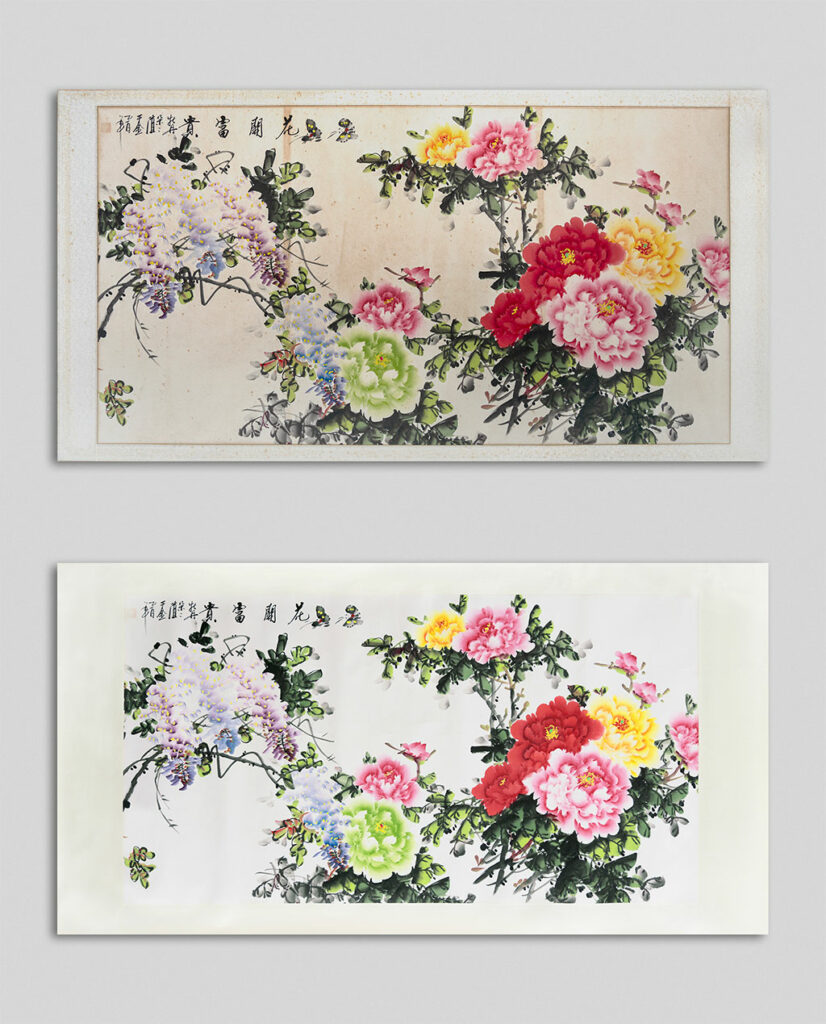Chinese ink on paper artworks, including traditional calligraphy and ink wash paintings, are not only culturally significant but also highly sensitive to environmental factors. One of the most challenging issues these artworks face is mould growth, which can cause irreversible damage if not addressed promptly and properly. It is a particular issue in humid climates such as Singapore and even artworks that are professionally framed using conservation techniques are highly likely to suffer from such problems eventually.
Thankfully, dealing with mould and yellow spots on traditional Chinese Ink on paper works is an area where restoration results can be highly effective. As such, if your painting is showing such signs and the work has sentimental or monetary value, we would highly recommend reaching out to an art restoration specialist such as ourselves to address the issues.
We have an extensive portfolio of before and after photographs to help you appreciate (a) what can be achieved through proper restoration, and (b) the quality of our work. Please get in touch if you require a no obligation review and quote.

Understanding Mould and Its Effects
Mould is a type of fungus that thrives in damp, warm, and poorly ventilated environments. It appears as fuzzy, discoloured spots and can spread quickly, feeding on the organic materials in paper and ink. Mould damage can lead to staining, deterioration of paper fibers, and loss of pigment.
Long term, prevention is obviously the best cure
Some steps you can take to protect traditional Chinese ink on paper artworks are listed below. Many dedicated collectors actually leave their works rolled up and stored in a dedicated space, but this is often not viable for the vast majority of us who wish to simply enjoy the painting on the wall.
- Control Humidity and Temperature: Maintain a stable environment with humidity levels between 45-55% and temperatures around 18-22°C (65-72°F).
- Proper Storage: Store artworks in a dry, cool place. Use acid-free, archival-quality materials for storage.
- Good Ventilation: Ensure proper air circulation in storage and display areas.
- Regular Inspection: Frequently check stored artworks for early signs of mould.
Identifying Mould
Early detection is crucial. Look for:
- Discolouration (green, black, brown, yellow or white spots).
- A musty odor.
- Visible fuzzy growth on the surface.
Immediate Steps Upon Detection
- Isolate the Affected Artwork: Prevent mould from spreading by isolating the affected piece.
- Minimise Handling: Mould can spread through spores, so handle the artwork as little as possible and always with clean, dry hands or gloves.
Contact a professional
If the mould damage is extensive or the artwork is particularly valuable, seek help from a professional conservator. We have the experience and tools to properly assess and restore the artwork. Please do not attempt to clean the artwork yourself as there are specific steps and methods to ensure it is done to a high standard and without damage to the original artwork.
Conclusion
Dealing with mould on Chinese ink on paper works requires a combination of preventive measures, careful handling, and appropriate cleaning techniques. By maintaining optimal storage conditions and acting quickly at the first sign of mould, you can preserve these beautiful and culturally important pieces for future generations. Remember, when in doubt, consult a professional conservator to ensure the best care for your valuable artworks.

